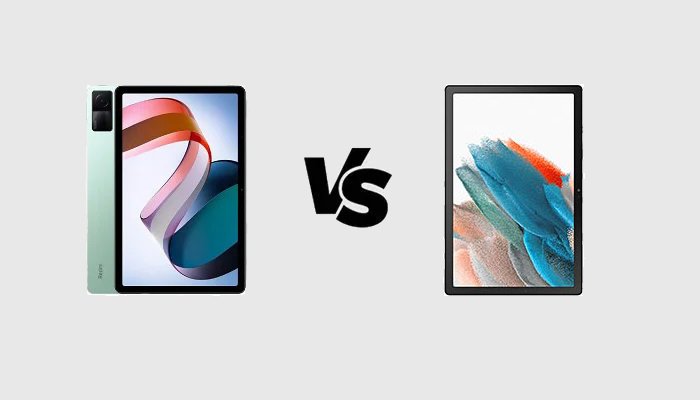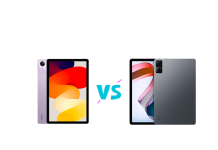Redmi finally launched its first tablet and it is definitely an amazing device. It debuted in the Asian market under the Redmi Pad moniker and it is bundled with midrange-class specifications. Despite being the first tablet from this brand, it is perfectly able to compete with the best concurrence in its segment. But there are several old tablet manufacturers to beat in order to conquer a good amount of users. One of the most experienced tablet manufacturers is Samsung and it produces several tablets in the affordable segment. One of the latest affordable tablets by the Korean giant is the Samsung Galaxy Tab A8 10.5, available in India and worldwide at very interesting prices. Here is a comparison between the main specifications of the Redmi Pad and the Samsung Galaxy Tab A8.

Xiaomi Redmi Pad vs Samsung Galaxy Tab A8 10.5
| Xiaomi Redmi Pad | Samsung Galaxy Tab A8 10.5 | |
|---|---|---|
| DIMENSIONS AND WEIGHT | 250.5 x 158.1 x 7.1 mm, 465 grams | 246.8 x 161.9 x 6.9 mm, 508 g |
| DISPLAY | 10.61 inches, 1200 x 2000p (Full HD+), IPS LCD | 10.5 inches, 1200 x 1920p (Full HD+), TFT LCD |
| PROCESSOR | MediaTek Helio G99, octa-core 2.2 GHz | Unisoc Tiger T618, octa-core 2 GHz |
| MEMORY | 3 GB RAM, 64 GB – 4 GB RAM, 128 GB – 6 GB RAM, 128 GB – micro SD slot | 2 GB RAM, 32 GB – 3 GB RAM, 32 GB – 4 GB RAM, 64 GB – 3 GB RAM, 128 GB – 4 GB RAM, 128 GB – micro SD dedicated slot |
| SOFTWARE | Android 12, MIUI | Android 11, One UI |
| CONNECTIVITY | Wi-Fi 802.11 a/b/g/n/ac, Bluetooth 5.2, GPS | Wi-Fi 802.11 a/b/g/n/ac, Bluetooth 5.0, GPS |
| CAMERA | Single 8 MP f/2.0 8 MP f/2.3 front camera |
Single 8 MP 5 MP front camera |
| BATTERY | 8000 mAh, fast charging 18W | 7040 mAh, fast charging 15W |
| ADDITIONAL FEATURES | Ultrawide front camera | Optional LTE connectivity |
Design
I love the design of the Samsung Galaxy Tab A8 10.5 because it has a very minimal look. On the rear side, there is no camera module, but just a single sensor placed directly on the rear cover. The tablet is very thin, just 6.9 mm, and it has a very high screen to body ratio thanks to narrow bezels around the display. Despite being very thin, this tablet is equipped with four stereo speakers and it is more compact than the Redmi Pad. Speaking of the Redmi Pad, it has an even higher screen to body ratio thanks to narrower bezels around the screen, but it is equipped with a big camera module ruining the rear design a bit. The presence of an aluminum frame is very interesting because it accounts for better build quality and a sturdier design. Even this model is equipped with four stereo speakers like its rival. It is slightly thicker and bigger, but on the other hand, it is more lightweight.
Display
Do you need one of the best displays in the affordable segment? If so, then you should go for the Redmi Pad. It has an IPS LCD panel able to show up to one billion colors with a diagonal of 10.61 inches, a Full HD Plus resolution of 1200 x 2000 pixels, a 90 Hz refresh rate, and a typical brightness of 400 nits. It offers great color reproduction, even though it is far from OLED panels found on midrange phones. And it is also very smooth thanks to its high refresh rate. The Samsung Galaxy Tab A8 has no way to compete with the Redmi Pad because its display is significatively inferior. It is a TFT LCD panel with a diagonal of 10.5 inches and a Full HD Plus resolution of 1200 x 1920 pixels, it does not have a high refresh rate, and it is able to show a lower amount of colors if compared to the Xiaomi tablet. Both have four stereo speakers as already mentioned above, but the Samsung Galaxy Tab A8 is the only one with a 3.5 mm audio jack allowing you to use wired earphones or headphones.
Specs & Software
The most powerful hardware belongs to the Redmi Pad and it is definitely much better than the hardware department of the Samsung Galaxy Tab A8. The Redmi Pad is powered by the Helio G99 mobile platform: one of the latest midrange chipsets by MediaTek. It is a processor built with a 6 nm production process and sporting an octa-core architecture composed of two Cortex A76 CPUs running at a max frequency of 2.2 GHz, six Cortex A55 CPUs running at a max frequency of 2 GHz, and a Mali G57 MC2 GPU. The chipset is paired with up to 6 GB of RAM and up to 128 GB of fast UFS 2.2 native storage. On the Samsung Galaxy Tab A8, you can find an entry-level chipset: the Unisoc Tiger T618 built with a 12 nm production process and sporting an octa-core architecture composed of two Cortex A75 CPUs running at 2 GHz, six Cortex A55 CPUs running at 2 GHz, and a Mali G52 MP2 GPU. Alongside the processor, there are up to 4 GB of RAM and up to 128 GB of native storage, furtherly expandable with a micro SD. Note that Redmi Pad runs Android 12, while the Samsung Galaxy Tab A8 ships with Android 11.
Camera
The rear cameras of these two tablets are more or less at the same level: the real difference is in the front camera, where the Redmi Pad wins thanks to a great 8 MP sensor with an ultrawide field of view.
Battery
Last but not least, the Redmi Pad has a bigger battery and it guarantees longer battery life not only thanks to its bigger capacity but also because of its 6 nm chipset consuming less energy.
Price
You need at least €250/$250 to purchase the Redmi Pad, while the Samsung Galaxy Tab A8 is available for less than €185/$185. The Redmi wins this comparison.
Xiaomi Redmi Pad vs Samsung Galaxy Tab A8: PRO and CONS
Xiaomi Redmi Pad
PRO
- Bigger battery
- Wider display
- Better front camera
- Better chipset
CONS
- Limited availability
Samsung Galaxy Tab A8 10.5
PRO
- Worldwide availability
- More affordable
- Optional LTE connectivity
- More memory configurations
- 3.5 mm audio jack
CONS
- Inferior chipset
- Smaller battery
RELATED






